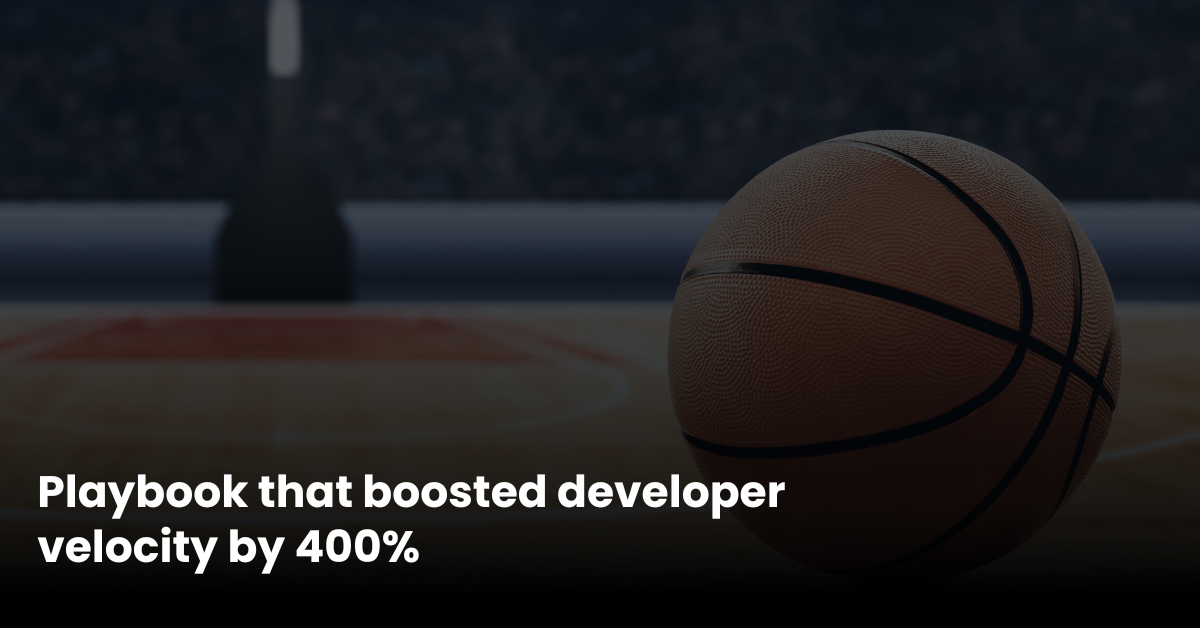The Platform Engineering Playbook That Transformed NBA Developer Velocity by 400%


How data-driven methodology eliminated developer friction and achieved championship-level delivery performance.
NBA achieved extraordinary results by applying sports analytics methodology to platform engineering: 400% developer velocity increase, release cycles reduced from weeks to under 10 minutes, and 50% fewer incidents. The key breakthrough? Treating developer productivity as a measurable system using the "Developer Burden Formula" to identify bottlenecks systematically. This case study reveals the three-pillar approach that separated this transformation from typical tool deployments—and provides a replicable playbook for platform engineering leaders ready to achieve championship-level results.
As CEO of StackGen, I've witnessed countless platform engineering transformations, but few demonstrate the power of systematic methodology like the case study that emerged from PlatformCon. A major enterprise applied sports analytics thinking to their software development lifecycle and achieved results that most organizations would consider impossible.
The Challenge: Waterfall in an Agile World (2019)
The starting point was painfully familiar:
- Release cycles: 1+ weeks - Still operating under Waterfall methodology with manual change request processes
- Manual, error-prone processes throughout SDLC - No CI/CD pipelines, manual build steps
- Complex legacy infrastructure - Legacy on-premises datacenter with poor incident response and documentation
- Frustrated developers - Spending more time on infrastructure than building experiences, with inadequate tooling and no reusable components
Most platform engineering initiatives attack these symptoms individually. This organization took a fundamentally different approach—they treated developer productivity as a measurable system.
The Data-Driven Breakthrough
What made this transformation exceptional was the systematic methodology. Instead of deploying tools and hoping for improvement, they quantified the problem using a simple but powerful framework:
Developer Burden Formula: # of Activities × Frequency × Time per Activity
This calculation became their north star. By mapping every activity developers performed—from daily standups to monthly access requests—they identified exactly where productivity was hemorrhaging. The results were shocking: 50% of helpdesk tickets were basic account access issues—a clear signal that identity management was a critical bottleneck hiding in plain sight.
They also conducted comprehensive SDLC bottleneck analysis, mapping every stage from Plan → Create → Verify → Release → Configure → Operate. This systems thinking approach ensured that optimizations would improve end-to-end flow rather than creating local improvements that don't move the needle.

The Three-Pillar Transformation Strategy
Armed with quantified insights, they implemented platform engineering based on three core principles:
- Make developers' lives easier (eliminate, optimize, automate)
- Target SDLC bottlenecks (throughput over utilization)
- Measure what matters (impact over effort, DORA metrics)
Key Implementations
- Enterprise Identity Revolution: They rolled out EntraID federated login across the League and all 30 teams, eliminating thousands of support hours each month. Account issues that previously took days were resolved in minutes.
- Shift-left security: SAST integration directly into IDEs and CI/CD pipelines moved security feedback from late-stage bottlenecks to real-time development assistance, cutting security issues by 50% before penetration testing.
- Automated DevOps to production: Built automated pipelines for safe, consistent production deployments, shrinking release cycles from weeks to minutes with 5x increase in deployment frequency.
- Cloud-first architecture with reusable IaC modules: Leveraging Terraform with StackGen for Infrastructure-as-Code, they standardized deployment patterns while ensuring compliance.
The Platform Architecture That Scaled
The technical foundation centered on five core capability areas, each treated as a product:
- Mobile Platform: NBA One and Team One mobile platforms for league users and team users respectively.
- User Registration & Management: Universal Widget for client login, ELM/ASMS systems, and User Identity API through Akamai Identity Cloud.
- Enterprise Data: NBA One Graph (Apollo Enterprise Graph) and Search Platform using Solr and 3RDisearch for unified data access.
- Common Application Services: FileStore Service API (Azure Blob Storage), Email Service API (Sendgrid), FlowState API (Azure Pub-Sub Service), and NBA Proxy Kit API as a bridge to internal APIs.
- DevOps Capabilities: YAML Pipelines, IaC with Terraform and StackGen, plus SAST and DAST scanning throughout the development lifecycle.
- AI Platform: Content Insight API with Native RAG and cloud-based AI integration.
The Results: Championship-Level Performance
The transformation delivered measurable, dramatic improvements:
- 400% increase in developer velocity
- Sub-10 minute release cycles (down from 1+ weeks)
- 50% reduction in incidents
- 20+ point increase in developer engagement scores
The major drivers of cycle time reduction were eliminating weekly reviews, shifting left on security, and resolving identity issues—proving that systematic bottleneck elimination creates compounding improvements.
Why Most Platform Engineering Fails
Having observed hundreds of platform initiatives, I've identified the critical differentiators:
Successful transformations start with measurement. The Developer Burden Formula provides a quantitative foundation for every decision, preventing the common trap of solving imaginary problems.
They focus on throughput over utilization. Rather than keeping developers busy, elite platform teams optimize for end-to-end delivery speed.
They apply systems thinking. By mapping entire workflows, they prevent local optimizations that don't improve overall system performance.

The Future: Infrastructure-as-Code with AI
Autonomous Infrastructure is the Future. The next evolution of platform engineering represents the most significant advancement since the cloud revolution: Infrastructure-as-Code powered by AI agents and automated remediation. Leading teams are implementing AI-driven systems that go beyond static templates—advanced AI agents analyze application requirements, security policies, and usage patterns to automatically generate, deploy, and continuously optimize infrastructure configurations. These systems monitor infrastructure health in real-time, automatically detecting configuration drift and security vulnerabilities, then immediately implement fixes and learn from incidents. Early adopters are seeing 90% reduction in infrastructure setup time and near-zero configuration drift, with AI agents handling routine maintenance tasks that previously consumed significant platform engineering resources.
Key Takeaways for Platform Engineering Leaders
- Quantify developer burden before building solutions—measurement reveals where to focus
- Map your entire SDLC for bottlenecks—systems thinking prevents ineffective local optimizations
- Start with high-frequency, low-value work—identity management delivered massive ROI
- Measure impact, not effort—track DORA metrics and developer engagement
- Treat platform capabilities as products—sustainable improvement requires dedicated ownership
Tony Tran's Main Stage Talk Session at PlatformCon can be viewed here
Conclusion
The transformation documented here represents more than impressive metrics—it demonstrates that platform engineering, when approached with scientific rigor, can fundamentally reshape how organizations deliver software. The Developer Burden Formula and systematic SDLC analysis aren't just tools; they're a new way of thinking about developer productivity as an optimizable system. As we enter an era where AI-driven intent-to-infrastructure capabilities will further accelerate these gains, the organizations that master this methodology today will build insurmountable competitive advantages tomorrow. The playbook is proven, the results are measurable, and the only question remaining is how quickly your organization will implement these championship-level practices.
About StackGen:
StackGen is the pioneer in Autonomous Infrastructure Platform (AIP) technology, helping enterprises transition from manual Infrastructure-as-Code (IaC) management to fully autonomous operations. Founded by infrastructure automation experts and headquartered in the San Francisco Bay Area, StackGen serves leading companies across technology, financial services, manufacturing, and entertainment industries.